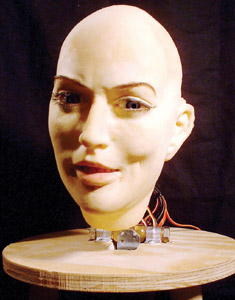![[Metroactive Features]](/features/gifs/feat468.gif)
[ Features Index | Silicon Valley | Metroactive Home | Archives ]

Biter Future Schlock Looking for reality at 'Wired' magazine's NextFest By Bob Ostertag LAST WEEKEND, at Wired magazine's NextFest 2004 in San Francisco, I got slapped with a Reality Helmet. Supposedly, this invention translates sounds and images in the real world into different sounds and images inside the helmet. When I strapped it on, all I got was a static pink and purple image and a recurring loop of not very interesting electronic sound. I tried waving my hands, clapping loudly and swinging my head from side to side—nothing. The problem, the man from Reality Helmet explained, was that we were in the wrong environment. Not a good one for the helmet. Right helmet, wrong reality. Many of the inventions at NextFest seemed to be seeking the right reality. Take the Gummi from Sony, a "bendable, credit-card-sized computer interface." The idea is that instead of typing or moving a joystick, you bend this little credit-card thingy. Not obvious to you what the advantage might be? Me neither. Unfortunately, I remain unenlightened, because the Gummi had broken. "It worked really well this morning," the nice young rep said helpfully. Nearby, "You're the Conductor: A Digital Conducting Experience for the Public" promised me "a visceral sense of what it feels like to conduct a real orchestra." Standing in front of a symphony orchestra projected onto a screen, I waved around a microphone-size object. The faster I waved, the faster the video played. The farther I moved it from side to side, the louder the music got. Are you listening, Michael Tilson-Thomas? That's what you orchestra conductors do, right? Control the speed and volume? Incredibly, the contraption is the result of the combined efforts of Immersion Music, Stanford University and ETH Zurich. Even more incredibly, it is booked two years out in museums around the country. Next to the canned orchestra I found the Intel pavilion festively adorned with banners proclaiming, "In the future, you will not have to learn about technology. Technology will learn about you." "Technology will learn about me?" I asked the Intel rep. "Yes," he beamed. "Sounds like a nightmare," I said. There was one of those awkward moments. "Yes, there is an element of that," he answered, smile still frozen in place. Next stop: the KBOT by Human Emulation Robotics. KBOTs are somewhat lifelike heads covered with a skinlike material and filled with little motors and chips. They are capable of making humanlike expressions. The display placard informed us that KBOT's applications include "Advertising and Marketing" and "High-End Toys." Many of the exhibit placards announced the technology's usefulness for "Advertising and Marketing" and "High-End Toys." The other common applications were "Military" and "Security." War and play, marketing and security—it's getting hard to keep things straight these days. Still pondering this subtle divide, I headed to the "Future of Security" section and the kiosk for Brain Fingerprinting Laboratories. "Brain fingerprinting can detect whether specific information is stored in a person's brain." Brain fingerprinters show you a series of objects, and by monitoring your brain, they can tell which of them you have seen before. None of that old-fashioned "Are you gonna talk?" stuff. As long as they can keep your eyes open, they can tell what you know. Feeling secure? Finally, I stopped by the car displays. Both G.M. and G.E. were showing hydrogen-fuel-cell car prototypes. They look really cool. They have very futuristic lines. They are the stars of the whole show. The only problem is where to get the hydrogen. Since it doesn't exist naturally, it has to be extracted. This could be done in a very dirty way, say, with a coal-fired plant or it could be done with, um, some cleaner technology that does not yet exist. There were no hydrogen-extraction technologies on display at the NextFest. Right helmet, wrong reality.
Send a letter to the editor about this story to letters@metronews.com. [ Silicon Valley | Metroactive Home | Archives ]
|
From the June 9-15, 2004 issue of Metro, Silicon Valley's Weekly Newspaper.
Copyright © Metro Publishing Inc. Metroactive is affiliated with the Boulevards Network.
For more information about the San Jose/Silicon Valley area, visit sanjose.com.